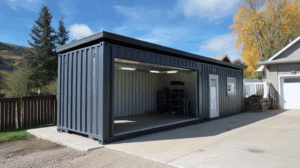Revolutionary Garage Solutions: Unleash Your Creativity with Shipping Container Conversions
Are you tired of your boring, cluttered garage? Do you dream of having a space that not only provides ample storage but also serves as a creative sanctuary? Look no further than shipping container conversions. These innovative solutions are revolutionizing the way we think about garages, offering endless possibilities for customization and functionality.
The Versatility of Shipping Container Conversions
Shipping containers have long been used for transporting goods across the globe, but their potential as creative spaces is often overlooked. With their robust structure and modular design, these containers can be transformed into a wide range of functional spaces, including garages.
Whether you need extra storage for your tools and equipment or a dedicated workshop for your hobbies, a shipping container conversion can provide the perfect solution. These containers come in various sizes, allowing you to choose the one that best fits your needs. From a single 20-foot container to multiple containers combined, the options are limitless.
Customization Options
One of the most exciting aspects of shipping container conversions is the ability to customize them according to your unique preferences. With a little creativity and the help of professionals, you can turn a simple container into a stunning garage that reflects your personal style.
Exterior modifications can include adding windows and doors, painting the container to match your home’s aesthetic, or even installing a rooftop garden for a touch of greenery. Inside, you can install shelving units, workbenches, and tool storage systems to optimize the functionality of the space. The possibilities are endless, limited only by your imagination.
Benefits of Shipping Container Garages
Aside from their customizability, shipping container garages offer a range of benefits that make them an attractive alternative to traditional garage solutions.
Durability and Security
Shipping containers are built to withstand the harshest conditions at sea, making them incredibly durable and secure. Constructed from weather-resistant steel, these containers are designed to protect your belongings from the elements and keep them safe from intruders.
Cost-Effectiveness
Compared to building a traditional garage from scratch, shipping container conversions can be a more cost-effective solution. The containers themselves are relatively affordable, and the conversion process is often quicker and more straightforward than a traditional construction project. This can save you both time and money, allowing you to enjoy your new garage sooner.
Portability
Unlike traditional garages, shipping container conversions offer the advantage of portability. If you ever need to move or relocate, you can take your garage with you. This flexibility makes shipping container conversions a great option for renters or those who frequently change residences.
Conclusion
Shipping container conversions are revolutionizing the way we think about garages. With their versatility, customization options, and a range of benefits, these innovative solutions offer a unique opportunity to unleash your creativity and create a garage space that is truly your own. So, why settle for a traditional garage when you can have a one-of-a-kind shipping container conversion that reflects your style and meets your needs? Embrace the revolution and transform your garage into a functional and inspiring space today.
Out-of-the-Box Garage Ideas: Discover the Benefits of Shipping Container Conversions
Are you tired of your conventional garage? Looking for a unique and innovative way to transform your space? Look no further than shipping container conversions! These versatile metal structures are not only eco-friendly but also provide countless benefits when it comes to creating the perfect garage.
Embrace Sustainability
One of the major advantages of utilizing shipping containers for your garage conversion is the sustainability factor. With eco-consciousness on the rise, repurposing shipping containers helps to reduce waste and minimize the demand for new construction materials. By giving these containers a second life, you contribute to a more sustainable future for our planet.
Cost-Effective Solution
Converting a shipping container into a garage is a cost-effective alternative to traditional construction methods. The price of shipping containers is significantly lower than building a garage from scratch, saving you a substantial amount of money. Moreover, the structural integrity of these containers eliminates the need for extensive foundation work, further reducing your expenses.
Customization and Flexibility
Shipping containers provide a blank canvas for creativity, allowing you to customize your garage to your heart’s desire. Whether you envision a minimalistic design or a fully decked-out workshop, the possibilities are endless. You can easily modify the container’s interior and exterior, add windows for natural light, install shelving units, or even incorporate a mezzanine level for additional storage.
Portability and Mobility
Unlike traditional garages, shipping container conversions offer mobility and portability. If you decide to relocate or expand your property, you can easily transport your container garage to a new location. This flexibility gives you the freedom to adapt to changing circumstances without the hassle of rebuilding or leaving behind your beloved garage.
Durability and Security
Shipping containers are built to withstand harsh conditions and are designed to protect goods during long journeys at sea. This inherent durability makes them a perfect choice for a garage conversion. These robust metal structures are resistant to extreme weather conditions, pests, and burglaries, ensuring the safety and security of your vehicles, tools, and equipment.
Quick Installation
One of the most significant advantages of shipping container conversions is the speedy installation process. Unlike traditional construction, which can take months, converting a shipping container into a garage can be done in a matter of weeks. With minimal on-site work required, you can have your dream garage up and running in no time.
Versatility Beyond the Garage
Shipping containers offer versatility that extends beyond their use as garages. If you ever decide to repurpose your garage, these containers can easily transform into a home office, an art studio, a guest house, or even a gym. With a few modifications, you can adapt your space to suit your changing needs without investing in additional construction.
Conclusion
Shipping container conversions are the perfect solution for those seeking unique and practical garage ideas. From sustainability and cost-effectiveness to flexibility and durability, these converted structures offer countless benefits. So why settle for a conventional garage when you can think outside the box and create a space that truly reflects your personality and lifestyle? Embrace the endless possibilities of shipping container conversions and transform your garage into a one-of-a-kind haven.
Transforming Shipping Containers: The Ultimate Guide to Creating a Stylish Garage
Do you find yourself in need of extra space but lack the resources or time to build a traditional garage? Look no further than shipping containers! These versatile structures have taken the world by storm, offering an affordable and stylish solution for creating a garage space. In this ultimate guide, we will walk you through the process of transforming a shipping container into a stylish garage that suits your needs.
Step 1: Choosing the Right Container
The first step in creating a stylish garage is selecting the right shipping container. Consider the size and condition of the container. Most shipping containers come in standard sizes of 20 or 40 feet in length, so choose one that suits your space requirements. Additionally, inspect the container for any damages or rust, as this can affect the integrity of the structure.
Step 2: Preparing the Container
Before you start transforming the container, it’s important to prepare it properly. Begin by thoroughly cleaning the interior and exterior surfaces. Remove any loose paint or rust using a wire brush or sandpaper. Apply a primer to prevent further rusting and create a smooth surface for painting.
Step 3: Insulation and Ventilation
To make your garage comfortable and energy-efficient, insulation and ventilation are crucial. Insulate the container by adding foam panels or spray foam insulation to the walls and ceiling. This will help regulate temperatures and reduce noise. Install windows or vents for proper air circulation, ensuring a comfortable environment inside.
Step 4: Electrical and Plumbing
Consider your garage’s electrical and plumbing needs. Plan the placement of electrical outlets, lights, and switches according to your requirements. If you need access to water, consult a professional to install plumbing connections. Ensure that all electrical and plumbing work complies with local building codes and regulations.
Step 5: Flooring and Lighting
Choose a flooring option that is durable and easy to maintain. Popular choices include epoxy coatings, concrete sealants, or rubber flooring. Install proper lighting fixtures to brighten up the space. Consider a combination of overhead lights and task lighting to ensure optimal visibility.
Step 6: Customization and Storage Solutions
Now comes the fun part – customizing your garage! Add shelves, cabinets, and workbenches to maximize storage and functionality. Consider installing a wall-mounted pegboard to organize tools and equipment. Don’t forget to add personal touches, such as posters or wall art, to make the space uniquely yours.
Step 7: Exterior Finishes
To enhance the aesthetic appeal of your shipping container garage, consider adding exterior finishes. Paint the container in your preferred color or apply a vinyl wrap for a more modern look. Adding windows, awnings, or landscaping around the garage can create a welcoming and stylish exterior.
Step 8: Security and Safety Measures
Ensure the safety and security of your garage by installing proper locks and an alarm system. Consider adding security cameras to monitor the area. If you live in an area prone to extreme weather conditions, reinforce the container with additional support to withstand strong winds or earthquakes.
Step 9: Permits and Regulations
Before starting your shipping container garage project, check with local authorities for any permits or regulations you need to comply with. This will ensure that your garage is built legally and avoids any potential issues in the future.
Step 10: Enjoy Your Stylish Garage!
Once you have completed all the necessary steps, it’s time to enjoy your stylish shipping container garage! Whether you use it to store your vehicles, create a workshop, or as a personal space for hobbies, the possibilities are endless. Embrace the uniqueness and functionality of your transformed shipping container garage.
In conclusion, transforming a shipping container into a stylish garage is not only a cost-effective solution but also an opportunity to unleash your creativity. Follow these steps, and soon you’ll have a functional and aesthetically pleasing garage that will impress your friends and neighbors. Happy transforming!
The Modern Man Cave: Building a Functional and Trendy Garage Using Shipping Containers
Gone are the days of the traditional man cave tucked away in the basement. Today, more and more men are finding innovative ways to create their own personal retreats, and one of the most exciting trends is building a garage using shipping containers. Not only does this provide a unique and trendy space, but it also offers a functional and versatile solution for housing cars, tools, and a variety of hobbies.
Why Choose Shipping Containers?
Shipping containers have gained popularity in recent years due to their durability, affordability, and eco-friendly nature. These containers are designed to withstand extreme weather conditions, making them an excellent choice for a garage that can withstand the test of time. Additionally, repurposing shipping containers helps reduce waste and provides an alternative to traditional construction methods.
Designing Your Modern Man Cave
When it comes to designing a modern man cave using shipping containers, the possibilities are endless. Here are a few key considerations to keep in mind:
Size and Layout
Shipping containers come in various sizes, typically ranging from 20 to 40 feet in length. Consider the number of cars you plan to store and any additional space you might need for a workshop or storage area. Combining multiple containers can create a larger space and allow for more flexibility in design.
Insulation and Climate Control
To ensure a comfortable and functional space, proper insulation is crucial. Shipping containers are made of steel, which can transfer heat and cold easily. Adding insulation to the walls and ceiling will help maintain a comfortable temperature year-round. Additionally, consider installing climate control systems such as air conditioning or heating to further enhance the usability of your man cave.
Lighting and Ventilation
A well-lit and properly ventilated space is essential for any man cave. Shipping containers typically have limited natural light, so incorporating large windows or skylights can brighten up the interior and create an inviting atmosphere. Additionally, proper ventilation will help remove stale air and prevent humidity buildup, especially if you plan to use the space for activities such as woodworking or automotive maintenance.
Interior Design and Functionality
Your man cave should reflect your personal style and interests. Consider incorporating a theme that aligns with your hobbies or passions, whether it’s a vintage automotive theme, a sports memorabilia showcase, or a rustic workshop aesthetic. Choose materials and furnishings that are both functional and visually appealing. From custom cabinets and workbenches to comfortable seating areas, the possibilities are endless.
Benefits of a Shipping Container Man Cave
Building a man cave using shipping containers offers several unique benefits:
Affordability
Compared to traditional construction methods, using shipping containers can be a more cost-effective option. The containers themselves are relatively inexpensive, and repurposing them requires less labor and materials.
Quick Construction
Shipping container structures can be built relatively quickly compared to traditional construction projects. Since the containers are pre-fabricated, much of the construction work is already completed. This means you can start enjoying your man cave sooner.
Portability
One of the significant advantages of using shipping containers is their portability. If you ever decide to move or relocate, you can easily transport your man cave to a new location. This flexibility allows you to enjoy your space wherever you go.
Durability and Security
Shipping containers are built to withstand harsh conditions, making them incredibly durable and secure. They are resistant to fire, pests, and extreme weather, providing a safe and protected space for your belongings.
Conclusion
Building a functional and trendy garage using shipping containers is an exciting and innovative way to create the modern man cave of your dreams. With their durability, versatility, and eco-friendly nature, shipping containers offer the perfect solution for a unique and personalized space. Whether you’re a car enthusiast, a DIY enthusiast, or simply looking for a private retreat, a shipping container man cave is the ultimate combination of style and functionality. So why settle for a traditional garage when you can have a trendy and functional space that truly reflects your personality?
From Cargo to Car Haven: How to Build a Garage Out of Shipping Containers
If you’re in need of extra storage space or a secure place to park your vehicles, building a garage out of shipping containers might be the perfect solution. Not only are shipping containers readily available and relatively affordable, but they also offer durability, mobility, and a unique industrial aesthetic. In this guide, we’ll explore the steps involved in transforming a cargo container into a functional and stylish garage.
Step 1: Planning and Preparation
Before diving into the construction process, it’s essential to plan and prepare for your shipping container garage project. Here are a few key considerations to keep in mind:
-
Permits and Regulations: Check with your local building department to understand any permits or regulations that may apply to container conversions in your area. Ensure you have all the necessary approvals before starting the construction.
-
Site Selection: Choose a suitable location for your garage, considering factors such as accessibility, drainage, and proximity to utilities. Ensure there is enough space to accommodate the container and allow for easy maneuvering.
-
Container Selection: Decide on the size and number of containers you’ll need based on your storage requirements. Standard shipping containers come in various dimensions, typically ranging from 20 to 40 feet long. Consider the height, condition, and structural integrity of the containers before making a purchase.
-
Design and Layout: Sketch out a rough floor plan, taking into account the intended use of the garage. Consider factors like vehicle size, storage needs, workspace requirements, and any additional features you may want to incorporate, such as windows, doors, or insulation.
Step 2: Site Preparation
Once you have a clear plan in place, it’s time to prepare the site for your shipping container garage. Follow these steps to ensure a sturdy foundation:
-
Clear the Area: Remove any obstructions, debris, or vegetation from the chosen site. Level the ground using a shovel or a small excavator if necessary.
-
Foundation Options: Choose the appropriate foundation type based on your location and budget. Common options include concrete slabs, piers, or footings. Consult with a professional to determine the best choice for your specific needs.
-
Anchor the Containers: To secure the containers in place, consider using concrete footings or steel anchors. This will ensure stability and prevent shifting or movement over time.
Step 3: Container Modification
With the site prepared and the containers in place, it’s time to transform them into a functional garage. Here are the key steps involved in modifying the containers:
-
Cutting Openings: Use a plasma cutter or angle grinder to create openings for doors, windows, and any other desired entry points. Reinforce the cut edges with steel framing to maintain structural integrity.
-
Insulation and Ventilation: Install insulation materials to regulate temperature inside the garage and reduce condensation. Consider using spray foam insulation or rigid panels. Additionally, ensure proper ventilation by adding vents or exhaust fans to prevent moisture buildup and improve air circulation.
-
Electrical and Plumbing: Depending on your needs, you may want to install electrical outlets, lighting fixtures, or plumbing connections. Consult with a licensed electrician and plumber to ensure safe and code-compliant installations.
-
Interior Finishes: Finish the interior walls and floors with materials that suit your preferences and intended use. Options include drywall, plywood, or metal panels. Paint or seal the surfaces to enhance aesthetics and protect against corrosion.
Step 4: Exterior Enhancements
To make your shipping container garage more visually appealing and functional, consider the following enhancements:
-
Exterior Coating: Apply a weather-resistant coating or paint to protect the container from rust and corrosion. This will also allow you to customize the appearance and match it with your surroundings.
-
Roofing: Consider adding a pitched roof or installing a metal roof over the containers to improve drainage and enhance the overall aesthetics.
-
Doors and Windows: Install sturdy, weather-sealed doors and windows to ensure security and natural light penetration. You can choose from a variety of options, including roll-up doors, sliding doors, or traditional entry doors.
Step 5: Security and Access
Finally, don’t forget to prioritize security and ease of access for your shipping container garage:
-
Locking Mechanisms: Install high-quality locks, preferably with reinforced steel doors, to ensure the safety of your vehicles and belongings.
-
Lighting and Surveillance: Consider installing motion-sensor lights and security cameras to deter potential intruders and enhance overall safety.
-
Accessibility: Design the layout to allow easy entry and exit for your vehicles. Consider adding ramps or driveways that can accommodate your specific needs.
By following these steps, you can transform a simple cargo container into a fully functional garage that meets your storage and parking requirements while adding a unique and stylish touch to your property. Get creative, consult professionals when needed, and enjoy your new car haven!





